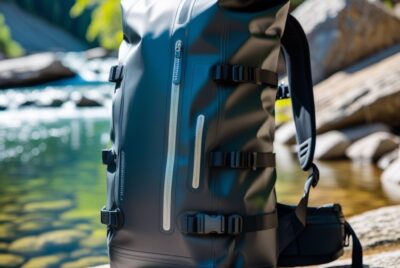Kayak FishFinder: Your Complete Guide
*We may earn a commission for purchases made using our links. Please see our disclosure to learn more.
Kayak FishFinder: Top Models and Buying Guide
Fishing from a kayak has become a popular activity for many anglers. Being on the water in a small, maneuverable vessel offers a unique and peaceful experience. A kayak FishFinder is a crucial tool for those looking to improve their fishing game. It helps anglers locate fish beneath the water, making every trip more successful and enjoyable.
There are several kayaks FishFinders available, each offering different features. Key aspects to consider include screen size, battery life, and the type of transducer. It’s important to choose one that is durable and water-resistant since it will be exposed to splashes and potential submersion.
We spent countless hours researching and testing various kayak FishFinders to determine which ones provide the best user experience and most accurate readings.
Best Kayak FishFinders
I’ve put together a list of the best kayak fish finders to help you make the best choice for your fishing adventures.
Garmin Striker 4 Kayak Fishfinder
This device is a solid choice for anyone looking to improve their fishing experience with reliable, clear sonar technology.
Pros
- Sharp, detailed sonar images
- Easy-to-use interface with buttons
- Compact and lightweight design
Cons
- Lacks detailed mapping
- Small display size may not suit everyone
- Limited to basic GPS functions
My experience with the Garmin Striker 4 was quite impressive. The ClearVu sonar technology delivered crisp, near-photographic images of what was underwater. Whether I was fishing in sweet or salty water, the device showed fish, structures, and objects clearly.
Setting up the device was a breeze. The keyed interface with dedicated buttons made it simple to navigate through different functions. Even for someone not tech-savvy, it’s straightforward to use.
On the downside, the screen is small at 3.5 inches. This might be a bit limiting for those who prefer larger displays. Also, the GPS feature is basic and lacks detailed maps, so it’s more for marking spots than navigating complex routes.
Despite these minor inconveniences, I found the Garmin Striker 4 to be reliable and efficient for casual fishing trips. If you are looking for a budget-friendly fishfinder that gets the job done, this is definitely worth considering.
Venterior Portable Fish Finder
A solid choice for kayak anglers looking to find fish quickly.
Pros
- Easy-to-read display
- Rechargeable battery
- Accurate readings
Cons
- Small screen size
- Sensor fragile in rough conditions
- Battery life varies with backlight
I recently tried out the Venterior Portable Fish Finder on my kayak trip. Its compact size was convenient, and the clear color screen made it easy to read even under bright sunlight. I liked how it provides water depth, fish size, and temperature details in an instant.
Casting the sensor into the water was straightforward. The sensitivity settings were useful for getting accurate readings, and I had no trouble detecting fish. The rechargeable battery lasted long enough for a full day of fishing when the backlight was kept low.
Using the fish finder in muddy water or around rocks requires extra care. The performance might drop in heavy waves, but it worked great on a calm lake. It’s also important to keep the sensor clean to maintain its accuracy. This tool is a nice addition to any fishing trip.
Humminbird PiranhaMAX 4 Fish Finder
If you’re looking for an easy-to-use fish finder with reliable features, this one is worth considering.
Pros
- Simple to use interface
- Dual Beam Sonar for versatility
- Adjustable mount
Cons
- Lacks some advanced features
- Limited to 13.5 volts
- Small mounting holes
Setting up the Humminbird PiranhaMAX 4 was straightforward, and the interface is user-friendly. The bright 4.3-inch color screen gives a clear view of what’s beneath my kayak, making fish identification easy. The Dual Beam Sonar offers flexibility, whether I need detailed views or broad coverage.
The tilt and swivel mount allow for quick adjustments, which is handy when the sun’s glare is a challenge. Despite its simplicity, the fish finder performs well, giving accurate readings on depth and fish location. The fish and depth alarms are useful and not overly intrusive.
One drawback is the power limit; it’s only rated for 13.5 volts, which could be an issue with some motors. Additionally, the mounting holes are small, requiring extra care during installation. Nonetheless, for the price, it’s a reliable device, especially for casual fishing trips.
Hawkeye FISHTRAX 1C-K Fish Finder
This product is a solid choice for kayak anglers looking for a simple, waterproof solution without needing an external battery.
Pros
- Easy to mount
- Fully waterproof
- No external battery needed
Cons
- Some depth inaccuracies
- May have screen issues
- Battery life concerns
Taking the Hawkeye FISHTRAX 1C-K out on the water was a breeze. The setup was straightforward, and I had it mounted on my kayak without a hitch. Its compact size fit well on my paddleboard too.
Although I appreciated its waterproof design, I noticed that the depth readings could sometimes be off. This wasn’t a big deal for casual fishing, but it might be a problem for more serious anglers.
Another thing to watch is the screen. On my third trip, it started acting up. Given these issues, it’s still a decent unit if you need a portable and easy-to-use fish finder for your paddlesport adventures.
Deeper PRO+ Smart Sonar Fishfinder
This Deeper PRO+ Smart Sonar is a great tool for anyone serious about kayak fishing.
Pros
- Easy to set up and use
- Impressive depth and target detection
- Reliable built-in GPS for mapping
Cons
- Battery life could be longer
- Initial cost is high
- Requires a Wi-Fi connection to sync
Using the Deeper PRO+ was straightforward and surprisingly quick to set up. I enjoyed how it could be hooked up to my kayak without needing any cables or drilling. The solid connectivity made it easy to sync with my phone.
Having this fish finder made my fishing trips more enjoyable. I was impressed by the real-time data it provided. The device could scan depths up to 260 feet, helping me locate fish and understand the underwater structure easily. The built-in GPS is helpful for creating maps, which I found really useful.
One thing to keep in mind is the battery life. I had to recharge it more often than I expected. The initial cost is on the higher side too, which might not be ideal for everyone. However, if you’re willing to make the investment, this fish finder can greatly enhance your fishing experience.
Lowrance HOOK Reveal 5″ FishFinder
This fish finder is a solid choice for any kayaker who wants to spot fish easily and navigate efficiently.
Pros
- Easy-to-read screen in daylight
- Auto-tuning saves time on adjustments
- FishReveal feature helps identify fish clearly
Cons
- GPS plotter has limited functionality
- Depth finder can freeze at higher speeds
- Can be difficult to connect to WiFi
I recently had the chance to try out the Lowrance HOOK Reveal 5″ FishFinder on my kayak, and I must say it performed impressively. The FishReveal feature was particularly useful, making it simple to distinguish between fish and other objects on the screen. The auto-tuning sonar was another highlight, automatically adjusting to give the best image without much fuss, which let me focus more on fishing rather than settings.
One of the standout features for me was the screen visibility. Even in bright sunlight, the display remained clear and easy to read. This made it much easier to track fish and understand the underwater structure. Navigation was mostly smooth, although I found the GPS plotter a bit lacking for more precise mapping.
On the downside, the depth finder tended to freeze when my kayak reached speeds over 6 mph, requiring a reset. Connecting to WiFi was also an issue, which limited some of the advanced features. Despite these minor setbacks, the overall experience with this fish finder was positive, and it proved to be a valuable tool for my fishing adventures.
Buying Guide for a Kayak Fishfinder
Choosing a Kayak FishFinder involves looking at several key features. Here are the main factors to consider:
Screen Size and Resolution
The screen size and resolution affect how easy it is to read underwater details. A larger, high-resolution screen provides clearer images.
Power and Frequency
Power determines how deep the sonar can reach. Higher power means better depth capability. Frequency affects the detail seen on the screen. Higher frequencies offer more detail but cover less area.
GPS Capability
Some fish finders have built-in GPS. This helps track locations and navigate waters easily.
Mounting Options
Make sure the fish finder can be mounted on your kayak. Check for compatibility with your kayak’s design and space.
Battery Life
A longer battery life ensures you won’t run out of power while on the water.
Transducer Quality
The transducer sends and receives sonar waves. A high-quality transducer provides better accuracy.
Ease of Use
Look for a user-friendly interface. Easier controls mean less time fiddling and more time fishing.
Portability
Consider the weight and size. A bulky device isn’t ideal for a small kayak. Look for lightweight and compact models.
Price Range
Fish finders vary greatly in price. Determine your budget and find a model that offers the best features within that range.
By keeping these factors in mind, you can choose the right Kayak FishFinder for your needs.
Frequently Asked Questions
Kayak FishFinders can help anglers locate fish more efficiently. Let’s address common questions that arise.
1. Can you mount a fishfinder on a kayak?
Yes, you can mount a fish finder on a kayak. Many fish finders come with mounting brackets or kits specifically designed for kayaks.
2. What are the key features to look for in a kayak fishfinder?
Look for features like GPS, water temperature sensors, and clear display screens. It’s also essential to consider the device’s battery life and the type of imaging it offers.
3. How does one install a fishfinder on a kayak?
To install a fish finder, attach the transducer to the hull using a compatible mount. Secure the display unit within easy reach, often on the dashboard. Ensure all cables are safely routed and waterproofed.
4. What are the benefits of using down imaging vs. side imaging on a kayak?
Down imaging provides detailed views directly below the kayak, helpful for identifying structures and fish. Side imaging offers broader views to the sides, allowing me to scan larger areas quickly and spot fish or obstacles near the kayak.
5. Which fish finders are compatible with kayaks?
Many brands offer models suitable for kayaks, such as Humminbird, Lowrance, and Garmin. These models are typically compact, have durable water-resistant designs, and often include features specifically beneficial for kayak fishing.










